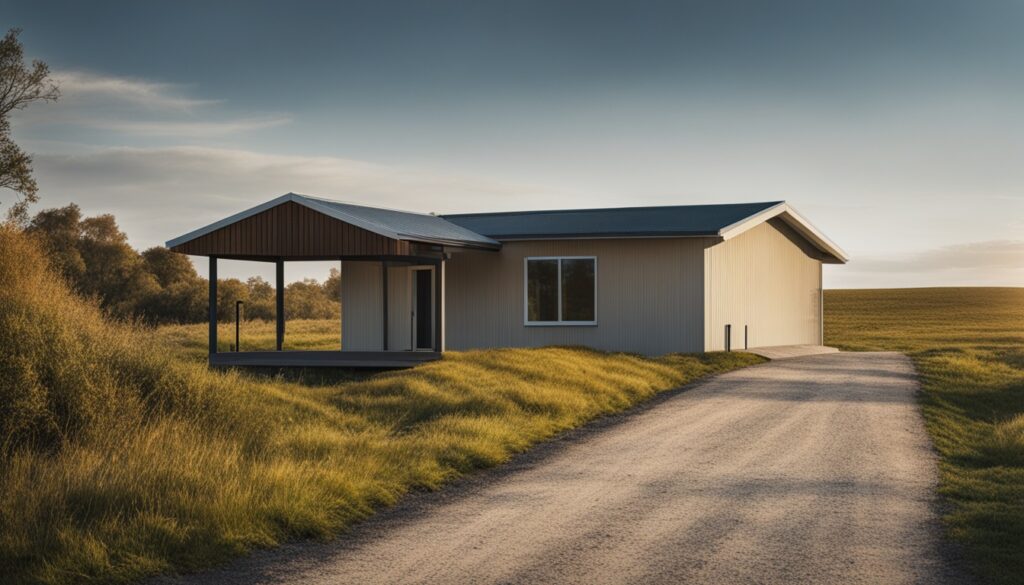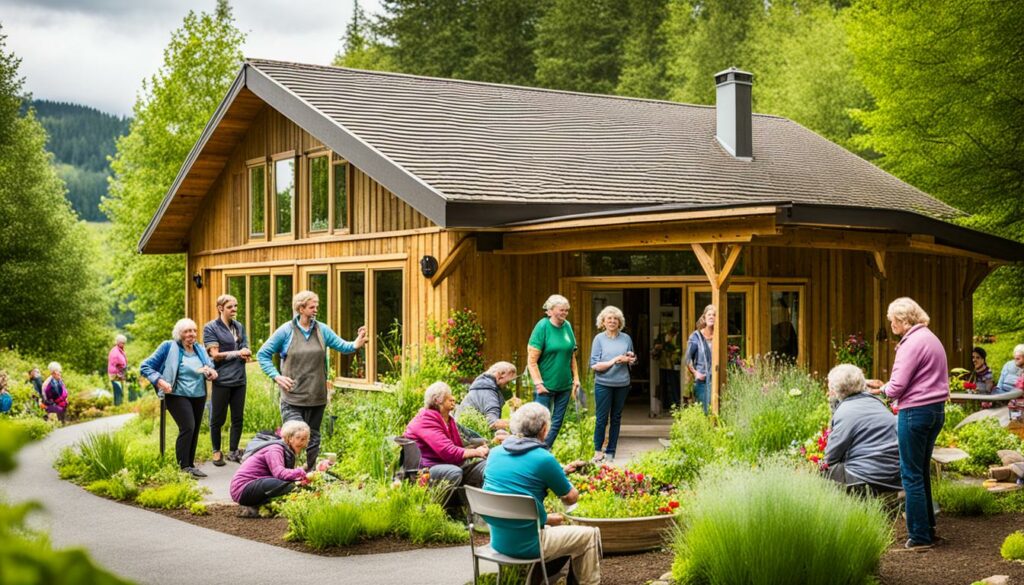Menu

Did you know, in 2022, a massive 23.0% of nonmetropolitan adults, around 7.7 million people, faced some mental illness? On top of that, 5.7% had serious thoughts about suicide. This shows the urgent need for rural mental health services.
Yet, in remote areas, getting mental health support is hard. One big problem is the lack of mental health professionals. By September 30, 2021, the HRSA said there were 3,426 rural areas lacking enough mental health experts.
Urban and rural areas have a big gap in healthcare services, according to the United States Census Bureau. Rural areas have fewer healthcare workers, more stigma, and longer distances to get help. These issues leave many without the mental health care they need.
It’s vital to remove barriers to mental health care in the countryside. We need to make mental health services fairer in these areas. This fight is crucial to help everyone in rural communities get the care they need.
Mental health issues are as common in the countryside as in the city. But, in rural areas, there’s not enough help for those who need it. This lack of support is a big problem, making it hard for people in the country to get the care they deserve.
Most rural places lack a psychiatrist, with almost 70% of counties not having one. There are also fewer mental health experts in these areas, especially in poorer places. This means not enough people can get the help they need, making the mental health situation in the countryside worse.
A national survey in 2016 showed that rural and city folks have different mental health needs. A study in 2014 found that mental health issues and trauma are big concerns in the countryside. It showed the urgent need for mental health resources aimed at rural areas.
Untreated mental health disorders affect not just the people suffering but their whole community. They lower work efficiency and weaken social bonds. Rural dwellers often lack health insurance coverage or face limits on mental health support. It makes it even harder to get the help they need.
In tight-knit country towns, people might avoid seeking help due to shame or fear of gossip. But, offering mental health support that respects their ways can change this. A lack of specialised mental healthcare services also hampers addressing their unique needs.
| Factors | Urban Areas | Rural Areas |
|---|---|---|
| Mental Health Service Access | Higher, More Providers | Lower, Few Providers |
| Insurance Coverage | More Coverage | Less Coverage |
| Confidentiality Concerns | Less Pronounced | High |
| Medicaid Reimbursement Rates | Inadequate but Better | Inadequate |
Setting up mobile health units and offering more online services could be part of the solution. Making sure there’s enough mental healthcare in rural areas will help countryside communities become stronger and healthier.
Accessing mental health services in rural areas is hard. Many adults outside cities face mental health issues. They need better and easier ways to get care.

Travel is a big issue for those living far from city mental health services. People in the countryside must cover long distances to get help. They have to go further than city dwellers do.
This far travel is due to the lack of nearby clinics or hospitals in rural areas. The problem got worse when over 100 rural hospitals closed from 2013 to 2020. This meant people had to travel up to 40 miles extra to get certain care.
Going these longer distances costs more money and uses up more time. It keeps people from regular mental health care.
Getting a ride is tough in the countryside. Public transport is scarce, so people have to rely on their cars. But if they can’t drive or don’t have a car, appointments are hard to make.
These issues lead to fewer people in rural areas using mental health services. Bad roads and weather make things worse. They make it hard to travel, so people often miss out on care.
About 7.7 million people living outside cities said they had mental health problems in 2022. That’s 23.0% of the rural population. Out of this number, 1.9 million had serious thoughts of suicide. But, they still have problems getting to the services they need.
We must face these issues to give everyone the same health care chances. This will help make better use of remote services and telehealth. Everyone, no matter where they live, deserves good mental health support.
Rural areas still lack enough mental health professionals. This makes it hard for people there to get healthcare. Mental health issues are common in the countryside. For example, 7.7 million adults in the countryside faced mental health problems in 2022. Yet, most mental health providers work in cities, not rural areas.
In 2021, the Health Resources and Services Administration found 3,426 rural Mental Health Professional Shortage Areas. They say 1,597 more mental health workers are needed in these places. This gap shows how urgent the lack of providers is in the countryside.
Rural areas lack mental health workers like psychiatrists and nurse practitioners the most. Almost 70% of rural counties have no psychiatrist. And 81% have no psychiatric nurse practitioner. So, rural people often can’t get the mental care they need close to home.
This situation leads to long waits for mental health help. Such long waits are common, keeping many from getting timely mental care. As a result, 1.9 million rural adults had serious thoughts about suicide in one year. Low payments from insurers like Medicaid can also reduce the number of mental health professionals in rural areas.
One solution to these problems is using teleservices, like telehealth. Telehealth can help by making care more accessible. But just using telehealth isn’t enough. To really help rural areas, we need more money and smart policies. These efforts should attract more mental health workers to places that need them the most.

Getting mental health services in the countryside can be hard for many. It’s more expensive in rural areas, which keeps some folks from getting help. A lot of rural places don’t have enough mental health experts. Nearly 70% of them don’t have a psychiatrist.
This makes care cost more because there aren’t many providers. Plus, if you’re living far from help, prices can get really high.
Healthcare costs a lot in the countryside for a few reasons. For example, doctors might not get enough money from Medicaid for their work. This makes some of them not want to work in rural areas.
So, it’s harder to find mental health care there. This raises the prices for people who need it. We can make care more affordable by using mobile clinics and offering telehealth. These could cut what you have to pay by lowering travel costs and making care more available.
Insurances can make getting mental health care even harder in rural places. People in the countryside are likelier not to have it. This makes getting mental health services more of a financial struggle.
Even if you have insurance, it might not cover some services. So, those services become very expensive. Fixing insurance issues is key to helping everyone get the care they need.
And, tailoring the care to fit the culture can help more people feel like they can get help. This is true for those living in the most diverse rural areas.
Factors such as mental health stigma in small rural communities and the associated confidentially concerns further prove challenging, deterring individuals from seeking the mental healthcare they need.
| Aspect | Rural Areas | Urban Areas |
|---|---|---|
| Uninsured Rate | Higher | Lower |
| Medicaid Reimbursement | Inadequate | More Adequate |
| Coverage of Services | Often Limited | More Comprehensive |
Making mental health services affordable is a big problem. We need to solve it, so rural folks can get the care they need. By working on costs and insurance, everyone in rural areas can get fair access to health care.
Dealing with mental health stigma in the countryside is tricky, with how people see things and worries about secrecy being key. Sadly, around 70% of rural areas have no psychiatrist. This makes it harder for people to get mental health help. It means they often have to go to general doctors who might not know enough about mental health issues.
In the country, what others think about mental health problems can stop someone from seeking help. Things like one’s background, like race and language, can really matter. In small communities, people might be afraid of how others will see them if they asked a mental health expert for help.
For those without a car in the countryside, getting the help they need can be even harder. This makes it tough to go to places where they can get lots of mental health services. There also might not be good public transport to help out, adding more hurdles.
In the countryside, everyone knows everyone, which makes keeping health issues private extra hard. This can really stop people from getting much-needed help for fear of being talked about. It’s important to deal with this issue to help mental health in these areas and get more people to ask for help without worry.
Making things better needs everyone to understand why mental health is crucial and to keep what’s said private. Teaching people and changing how they think about mental health can make places more welcoming. Also, making sure health records stay confidential helps people feel safer when they reach out for help.
To beat mental health stigma, lots of steps are needed. This includes teaching communities, changing rules, and ensuring more mental health help is around. By getting over these challenges, we can make mental health better in the countryside and create a welcoming space for all. For more info on difficulties with mental health care in rural places, check out this complete guide.
Telehealth is now a key solution for reaching out with mental health help, especially in places far from big cities. The COVID-19 pandemic made everyone see its worth. It can help people in rural areas connect with mental health help from afar. Studies show it really works. Doctors have made good progress in treating mental health over the phone or computer.

Telehealth has many upsides. It lets doctors treat a wide range of problems without the need for long patient trips. Imagine needing emergency help. A doctor could see you right then on a video call. This fast help could be a lifesaver.
Also, talking to a doctor on a video call can bridge the gap when specialist services are needed. It’s like having the doctor in the room with you. Telehealth makes special services like heart care, mental health help, x-rays, and pharmacy advice more available in country areas. This way, patients can get the care they need without travelling far.
But telehealth for mental health also faces some hurdles. First, not everyone in the countryside has good internet. And they need it to use telehealth services. Learning to use new tech can be hard for both the patient and the doctor. Then, there’s the problem of how to pay for these services.
Many rules changed during the pandemic to make it easier to use telehealth. But, keeping these changes and making telehealth better in the future needs work. People need to keep working together to solve these problems. This way, everyone can keep using telehealth to get the mental health help they need.
Mental health service integration into primary care is key in improving healthcare in rural areas. It makes care more complete. This way, mental health problems get the quick attention they need.
Seamless Care: Cherokee Health Systems have shown how to do this well by putting behavioural health experts in primary care teams. They train others to do the same, which spreads the success far and wide.
Video Case Studies: In places like the Sierra Clinic in rural Nevada, video case studies highlight how smoothly primary care and mental health providers can work together. These studies prove that with good planning, integration can truly help.
Workflows and Warm Hand-offs: Good coordination and support are essential for the success of mental health service integration. Even though some tasks, like meetings, don’t directly bring in money, they are vital.
Telemedicine: In areas where seeing a specialist in person is hard, telemedicine steps in. It meets the goals of rural health policies by leveling the healthcare field.
So, joining mental health services with primary care is a major step in helping rural areas. It brings reliable and effective care closer to everyone. This leads to a healthier and stronger community.
Rural areas face unique mental health challenges. This is shown by the 23.0% of nonmetropolitan adults with mental illnesses in 2022. Also, 5.7% have serious thoughts of suicide. These problems highlight the need for specific support in these areas. Unfortunately, rural communities often lack enough mental health resources.

Developing local initiatives helps close these gaps. These *community-based initiatives* use nearby resources and consider the local culture. This approach ensures mental health support is effective and lasting.
Local efforts play a key role in reaching rural areas. Key strategies include:
Many rural areas have seen great results from mental health outreach. The REACH programme trains health workers in some states, leading to better mental health and less substance abuse. The Rural Health Equity Research Centre also helps by looking into substance abuse, healthcare access, and community health.
The National Association for Rural Mental Health (NARMH) is another success story. It offers a space for rural health experts to exchange ideas. These successful mental health programs meet short-term needs and set the stage for future health improvement.
Suicide rates in the countryside are very high. This makes fighting suicide a major task in these places. The Substance Abuse and Mental Health Services Administration shows us that mental health in rural and city areas is very different.
In 2022, about 1.9 million grown-ups in the country thought seriously about suicide. This number is significant, making up 5.7% of the adult countryside population. We also see that more suicides happen in rural spots than in cities.
When we look at mental health numbers, we find some serious issues in the countryside. For example, young Native Americans’ and Alaskans’ suicide rates are much higher than the norm. In some cases, they’re two-and-a-half times the national average. Youth suicides and suicides with guns are also more common in these areas.
This shows us that rural places face unique health problems. Things like being far from help, not having many mental health experts around, and economic issues make things worse.
Dealing with these big problems means working together. Local groups, better online health help, and talking more about mental health can really help. Where this has been tried, some places have seen less suicide. They focus on teaching, supporting, and helping in tough times.
The American Journal of Preventive Medicine talks about good health work in empty areas. Helping online, through telehealth, is also a great idea. But, it’s tricky because of the costs and if people will use it.
The data and studies tell us we need many ways to fight suicide. This includes more mental health help, working together in communities, and breaking down the problems that stop people from getting help. This could be how we make things better.
| Key Statistics | Rural Areas | Urban Areas |
|---|---|---|
| Adults with Serious Thoughts of Suicide (2022) | 1.9 million (5.7%) | Lower |
| Suicide Rate Among Youth | Higher | Lower |
| Suicide Rate by Firearms | Higher | Lower |
| Suicide Rate – American Indians & Alaska Natives (15-34 years) | 2.5 times national average | Lower |

Support networks are key in helping people deal with mental health challenges, especially in the countryside. They include family, friends, and groups from the community. These networks offer both emotional help and the chance to get the needed services for mental health issues.
Family plays a big part in supporting mental health. They make sure their loved ones feel looked after and understood. This is very important in rural areas where professional help might be hard to find.
Families help by talking openly and fixing misunderstandings. They also support you all the way, helping to stop the shame of mental health issues. Friends are great too. They show you they care, offer you an ear, and cheer you up in tough times.
Community groups are so important when it comes to getting help for mental health. They step in where there’s a lack of mental health experts in the countryside. They provide lots of services like counselling, support groups, and workshops to teach you how to handle mental health issues better.
These groups also fight to stamp out the shame by educating and spreading the word about mental health. Their work doesn’t just help people directly; it also makes the whole local mental health system stronger. Community groups often team up with doctors and others to provide a wide range of support.
Improving rural mental health needs strong policy work. There are several major government initiatives for rural health happening now. They aim to make sure people in rural areas get the mental health support they need.
The Health Resources and Services Administration (HRSA) plays a big role. They are working to fight the lack of mental health experts in the countryside. By September 2021, they found 3,426 places lacking enough mental health help.
These include places where people can get scholarships, have their loans forgiven, and get other bonuses. The aim is to draw more experts to help where they are most needed.
Thanks to HRSA programmes, more people in remote areas can now get direct mental health help. This is important as around 23.0% of adults in the country side were suffering from mental issues in 2022.
Putting funding for mental health services is key. It helps improve the quality of mental health care in rural spots. Grants and special resources are working hard to help areas without enough health experts.
About 1,597 more experts are needed to make mental health care better in those areas. Better funding means services are not just there but also easy to reach. This helps with big problems like how far services are or not having enough ways to get there.
Many efforts are focusing on adding telehealth services. They are a new and promising way to overcome the distances and the lack of experts. Using modern tech this way helps make mental health care more equal across the country.
There is a critical lack of mental health professionals in rural areas. This issue needs specific training and recruiting efforts to be fixed. Around 62 million Americans (20-23% of the U.S. population) live in rural or frontier counties. They urgently need more mental health services. Sadly, 75% of these places don’t have enough advanced behavioural health practitioners. This leads to less access to mental healthcare compared to cities.
Special education programmes are key for preparing health workers for rural needs. Nebraska’s Behavioral Health Education Center has begun special initiatives for high school students. This effort attracted 300 students from 52 counties. A large number of these students, 81%, went on to college. This effectively creates a path for future mental health professionals.
Additionally, focused training programmes helped increase the number of qualified health workers by 15% in underserved areas.
Incentive schemes are crucial for pulling healthcare pros into rural areas. There are many types of financial aids available. These include the HRSA Behavioral Health Workforce Program and AmeriCorps for internships. There are also USDA grants for rural addiction counselling.
Tax benefits such as the New Mexico Rural Health Professional Tax Credit and the Louisiana Small Town Health Professionals Tax Credit are also available. Proposed policies, like Oklahoma’s HB2511, want to make rural roles less financially challenging. This makes working in rural areas more appealing.
Effective recruitment involves uniting different organisations. This is done through online platforms like Nebraska Behavioral HealthJobs.com. Such efforts connect job seekers with rural health providers. Collaborations between multiple training programs and rural communities are key strategies. They have proven successful in various states.
There are fewer mental health providers in rural areas. Also, people might feel ashamed about seeking help.tTravelling long distances is common for those who need support.
Over 7.7 million adults in areas without cities had mental illness in 2016. This shows how many people need help.
Mental health challenges affect everyone’s health, productivity, and how close people feel.tIt’s key to find ways to help these communities thrive.
Long distances from mental health services can break the chain of regular care.tThis means fewer people in rural areas use these services.
Public transport is scarce, so people use their cars. But not everyone has a car.tThis makes it hard for some to seek mental health support.
No, there aren’t enough mental health experts in the countryside. This means waiting a long time to get help.
Healthcare can be costly, and many rural people lack insurance.tThis makes seeing a mental health professional harder.
Stigma may stop individuals from seeking help, fearing what others will think.tWorking to change these beliefs is key.
Telehealth cuts down on travel thanks to online support.tIt’s a great help for those far from professionals.
Using telehealth needs good internet and adjustment from both sides.tPaying for these remote services can also be tricky.
By having mental health and general health together, people get better care.tIt’s easier for rural folk to find help this way.
Local projects know best how to support their own.tThey cover special needs and help more people find mental health support.
Suicide rates are high outside cities, which is why we need focused plans.tThese efforts are a big part of public health work.
Family, friends, and local groups are key for support and finding services.tThey make it easier to deal with mental health together.
Governments are putting in money and plans to help more people.tThese steps aim to make mental health care fairer and better in the countryside.
Teaching, bonuses, and tax breaks make rural jobs more appealing to experts.tThey are part of the plan to offer better service in the country.